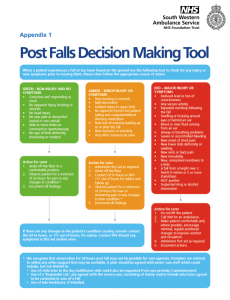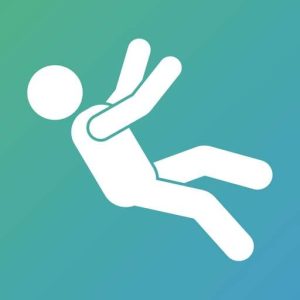The Best Fall Assessment Tools For Care Homes In 2024

Why is a post-falls decision support tool needed?
A lack of confidence and appropriate tools among care staff to safely assess and respond to falls that occur in care homes and in the community is a major reason for high numbers of unnecessary ambulance call-outs to falls.
Many ICBs are actively looking at how they can solve this problem, with most looking at implementing post falls decision-making tools and training to care homes and care organisations, to empower and upskill staff to respond to falls themselves.
Care Homes themselves are also looking at ways to streamline their post-falls response and the reporting of falls that occur in their homes.
In this article, we will be comparing the best falls assessment tools suitable for care homes, covering the positives and drawbacks of each tool to help you in your decision.
Paper-based assessment tools

Paper-based assessment tools such as SWAST’s Post Fall Assessment Checklist (🡥) have been created to provide an easily accessible assessment tool to be printed off and completed physically by a caregiver. Certain NHS trusts and care homes may also create their own paper-based assessment tools to suit the needs of the care home or the region.
Benefits of paper-based assessment tools
- Cost. Most paper-based assessment tools are available for anyone to download and use for free.
- Can be customised to your specific needs. If an NHS trust or care home group is creating the tool themselves, they can adapt it to suit their particular needs. For example, an NHS trust may want to include referral information for local services such as falls response services or falls prevention groups that most generic tools wouldn’t include.
Drawbacks of paper-based assessment tools
- No automatic integration with digital systems such as patient record systems, increasing the amount of paperwork and manual transfer of data after each incident.
- Environmental impact. Using paper-based tools goes against the trend towards paperless systems and methods, and isn’t environmentally sustainable.
ISTUMBLE

The ISTUMBLE App is trademarked by Mangar, part of the Winncare Group. The ISTUMBLE app has been designed to perform a health assessment on a fallen person and check for injury, before lifting them on a Mangar lifting cushion. ISTUMBLE is based on guidance from West Midlands Ambulance Service.
Positives of ISTUMBLE
- Free of charge. ISTUMBLE is a free-of-charge app, available in app stores for anyone to download and use.
- Easy to use. ISTUMBLE has been designed to be intuitive and simple for carers to use, and by answering a few short questions they can decide whether to call 999 for an ambulance. It also includes videos on how to lift using the Mangar cushions at the end of the assessment.
- Customisable. ISTUMBLE can be customised with tailored clinical pathways to reflect the pathways in place in your area.
- Certified. ISTUMBLE is ORCHA certified.
Drawbacks of ISTUMBLE
- Only able to be used with Mangar cushions. Winncare state that the ISTUMBLE app is ‘only compatible with Mangar lifting cushions’, which restricts its use if your care home uses alternative equipment such as Raizer chairs.
- Requires access to a phone or tablet. ISTUMBLE is an app, available for Android or iOS, so it can only be used if staff have access to a phone or a tablet with app store access.
- Lack of detailed guidance. The guidance can be ambiguous; you are either told to call 999 or lift the fallen person yourself and there is no middle-ground for minor-injury falls, leading to more 999 referrals than may be necessary.
HelpFall

HelpFall is the digital post-falls decision-making and reporting tool that supports care staff to safely assess a person who has fallen and helps them decide whether to lift them from the floor using safe manual handling techniques and equipment.
HelpFall has been designed alongside ICBs and the NHS, and uses a traffic light system to categorise the fall and suggest what actions care staff should take based on their answers. HelpFall is based on the South Western Ambulance NHS Foundation Trust Post Fall Assessment Checklist (🡥).
You can find out more about HelpFall here.
Positives of HelpFall
- Prioritises reducing pressure on the NHS. One of the key problems ICBs identified with traditional tools was the risk-averse nature of the guidance. For example, if a person has fallen and suffered a minor cut to the arm, traditional tools would tell the responder to call 999. In reality, ‘minor injury’ falls can usually be treated within the care home or by an Urgent Community Response team, and we have built HelpFall to reflect this and to only revert to 999 for major injury falls.
- Up-to-date guidance. HelpFall has been built to reflect the most up-to-date guidance from NICE and NHS England. HelpFall’s traffic light system directly reflects the three tiers for falls, set out by NHS England in their ‘Going Further for Winter’ guidance – see here. More than just a checklist, HelpFall suggests actions the care staff should take in each situation.
- Reporting. Every time HelpFall is used, an incident report is generated and sent to the care home, to be uploaded to patient record systems and shared with the appropriate teams. ICBs can also receive quarterly insights reports (see example here), which give a clear and accurate analysis of the causes and outcomes of falls, enabling the ICB to put appropriate programmes and interventions in place.
- Can be used in conjunction with any lifting equipment. Whilst we supply the Raizer lifting chair at Felgains, we have designed HelpFall to be able to be used regardless of the type of equipment you use to lift the fallen person off the floor. In fact, at the end of the assessment we have included instructional videos explaining how to lift a fallen person using either a Hoist, Mangar Cushion, Raizer Chair, or 2 dining chairs.
- Customisable. HelpFall can be customised with tailored clinical pathways to reflect the pathways in place in your area.
- Certified. HelpFall is NHS DTAC-ready and ORCHA Certified.
Drawbacks of HelpFall
- Cost. HelpFall is not a free-of-charge tool; we cover pricing in detail on this page.
- Requires access to a web app. The HelpFall tool is hosted on the web and accessed via a QR code or weblink, so an electronic device with broadband or mobile signal will be needed to use HelpFall (a hard-copy checklist is available as a backup). If a phone or tablet isn’t available, one of the care home’s PCs can be used.
Which post-fall assessment tool should you choose?
What post-falls decision support tool you actually choose to implement in your care home will come down to a number of factors that will be unique to you, however, I hope this article has given you a better idea of what each tool does, and the positives and negatives of each.
Often a care home or ICB will choose to trial a tool before implementing it fully. Suffolk and North East Essex ICB recently trialled the HelpFall tool in the care homes in their area – feel free to read the case study here.
Feel free to get in touch with us at 01473 741144, or by using the form at the bottom of this page to talk this through and get the process underway.
Related articles
The Best Falls Lifting Equipment for Care Homes in 2023
How To Use HelpFall To Assess A Fallen Person For Injury
How Do ICBs Implement HelpFall And The Raizer Lifting Chairs?
Get in touch
Got a question or want to send us a message? Let’s talk.